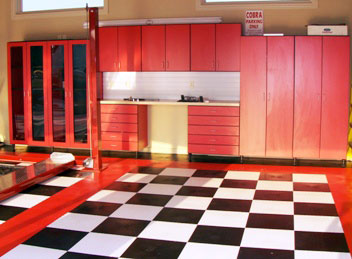7 Tips for Taking Your Garage from Grime to Glam

Go form Grimy to Glam in Your Garage
Your garage is more than just shelter for your cars. It is also typically an impromptu place to store everything from lawn equipment to boxes of old clothes. It’s unheated and often dimly lit, and it may be the unofficial everyday entrance to your home. Given all that, why put up with a garage that’s dirty, cluttered and filled with spider webs and junk? Especially when some elbow grease and do-it-yourself savvy could turn your garage into a better space to park your car — and more. Here are 10 options for transforming your garage from grimy to glamorous.
Finish the floor
An easy way to add style to your garage is by covering the dingy, oil-stained concrete floor. One option is to give that floor an epoxy coating with a product such as Valspar’s Quikrete, which is designed to create a clear or colorful surface that is smooth, tough and easy to clean. Garage floor tiles are another way to go. Many are designed to provide drainage for tracked-in snow or rain and to prevent slips and falls. These tiles are available in a variety of colors and patterns, as well as eco-friendly versions made from recycled plastic or rubber.
Add a grid wall
Storing things neatly and efficiently in your garage is largely a matter of taking advantage of your wall space.A typical two-car garage has only 400 square feet of floor space but more than 3,000 cubic feet of storage space. Adding a grid wall with specialized hooks and other fixtures can be a great way to organize everything from tools to athletic equipment. Most can be reconfigured, so they can change as your needs change. Conserve floor space wherever possible by hanging lawn tools and other equipment on the wall, ideally on the right side of the garage. The left side should be kept as clear as possible to make things easy for the driver.
Make room for stowage and storage
Traditional garage-organizing systems are pegboards or even just nails driven into the walls to hold rakes and brooms. But modern products are more durable and versatile. Garages are subject to drastic temperature changes, and shelves and cabinets installed there also must withstand the effects of moisture, dirt and even accidental bumps from inexpertly parked cars. Steel cabinets attached to the wall, off the floor, make it easy to clean the garage with a push broom or hose, and wheeled lockers offer protected storage that is easy to move and reconfigure.
Charge your car
President Barack Obama has said he’d like to see 1 million electric cars on U.S. roads by 2015. If you buy a battery-powered vehicle, you’ll want to be able to recharge it by plugging it in at night. The good news is that residential charging stations are already available from companies such as Siemens and Eaton. Home chargers come in two varieties, and your choice matters. Level 1 chargers run on standard, 120-volt household current, which means you can recharge your car using a standard outlet. But it will be a slow process, taking as long as 12 or 14 hours. A Level 2 charger requires a 220-volt current — and possibly an electrician to install it — but will recharge your car up to five times faster.
Get brighter
Many garages rely on a single, bare incandescent bulb for illumination. That’s perfectly adequate if you only need to see well enough to find your car when you leave for work in the morning and locate the door when you get home. If you want to use your garage for storage or as a workshop or garden shed, though, you’ll probably want to upgrade your lighting. Installing fixtures for fluorescent tubes can be practical and energy-efficient. Choices are available at a wide range of prices, starting at less than $20, but spending a bit more can be prudent. Less expensive fluorescent fixtures with magnetic ballasts may not work in cold temperatures. Large T12 tubes, at 40 watts, may not be as energy-efficient or show colors as accurately as smaller T8 tubes, at 32 watts, which are more expensive.
Let the sunshine in
Garages can be dark and dusty, but you can bring extra light and ventilation to the space by installing a skylight. It’s not a project for absolute beginners — after all, the job will require cutting through the roof with power tools. On the plus side, skylights themselves are available from retailers such as Lowe’s and Home Depot. Another factor that moves the project into the do-it-yourself category is that most garages’ roofs are accessible from below as well as above. This simplifies skylight installation by eliminating the need to cut through drywall ceilings and by removing the need to deal with rafters and trusses.
Let a laser be your guide
Having a glamorous garage is no good if your parking skills are not up to snuff; you’ll just wreck all those nice storage fixtures by banging into them with your car. Fortunately, there’s a cheap and easy-to-install solution. Laser parking guides are available for less than $25. Installed on the ceiling, devices such as the Chamberlain LiftMaster Laser Park Assist — which requires a compatible garage-door opener — or the Instapark laser parking system are activated when your car enters the garage. Simply pull forward until the laser beam’s red dot hits a designated spot on your dashboard, and you’ll know you’re parked in the right place. Of course, you’ll need to park perfectly on your own one more time to calibrate the gadget.
